|
Itineraries
– Itinerary III (second part)
by Gustavo Cannizzaro
Trinity
church

Trinity church
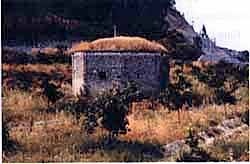
Trinity church
|
The originality of its
orthogonal shape with its sunken dome would suggest an oriental
style church. A close examination of its walls and its architectural
and decorative details which are not later additions, reveal
that the dating of the building with its oval apertures goes
back to the XVIII century. It probably was a private chapel
which deserves a more detailed research and a better valorisation
of the area around it.
Leaving the Aguglia-Mattanusa
area after Focŕ, a provincial road follows the banks of the
Allaro river. The road is a succession of green citrus plantations
which slowly turn into green leafed olive groves. It crosses
the river twice. The first bridge is called Ponte San Giovanni
and the second bridge crosses the river in the “Abatigiala”
area further on. The latter is found in a narrow passage among
high rocky peaks of spectacular formation, which lend the valley
a singular and suggestive aspect. At this point, the road splits
in two: one road leads steeply towards the towns of Ursini and
Campoli, among olive groves and centenary oaks, to join the
national road 110, after the Zija woods, towards the “Serre”.
The other road carries on along the Allaro towards the towns
of San Nicola and Calatria. Near San Nicola, after a walk along
the river bed path, lies the Hermitage of Saint Ilarione.
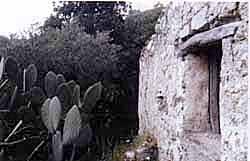
Abatigiala road
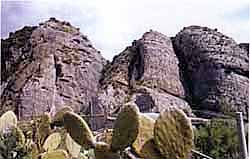
Abatigiala road |
The Hermitage
of Sant’Ilarione

The hermitage of Sant'Ilarione |
The hermitage rises in
a singular position on the tip of a rock insinuated along a bight
in the Allaro river. Davide Prota wrote about this sacred place,
in his first work: “The small church belonging to the hermitage,
was rendered what is left today, in 1627 by Carlo Carafa, Bishop
of Aversa, because it was only a chapel with a small annexed house
belonging to Esichio and another hermit.The continually liquid
blood of the Sicilian “beato”, Pietro Calaflore, who died here
in 1732, is kept in this church. The ampoule containing the blood
was sealed by Monsignor Idelfonso del Tufo. Outside the hermitage
there is an olive tree next to which, each year, a great bundle
of flaming wood is set. The flames, by miracle, do not damage
the trees”.

The hermitage of Sant'Ilarione |
Now, the church with its monastery, present late medieval architectural
characteristics with signs of more recent enlargements.
However, many architectural details and even the orientation of
the church , lead to believe that it had more ancient roots dating
back to Byzantine medieval monasticism, widespread in the territory.
This hypothesis gains even more value from the name of the church,
dedicated to the Patron Saint of Caulonia, Ilarione.
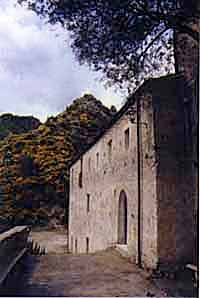
The hermitage of Sant'Ilarione |
According to tradition,
the Saint (whise life was recorded by San Girolami da Stridone
in the IV century) lived the last years of his life in this area:
this is where the cult and the origins of the hermitage come from.
Further on up the river there are waterfalls and the remains of
water mills. Further still one approaches the inaccessible area
of “Gurna Nigra” (one of the river’s sources), to which some fascinating
local legends are tied.
Also following the banks
of the Amusa is interesting. Along it, among citrus plantations,
olive groves and vineyards are ancient farmhouses, votive altars,
oil mills, the remains of the church of Santa Maria di Polzeri
and many water mills now mostly reduced to ruins. Further on is
the XVIII century church of Santa Maria di Crochi. A legend, narrated by
Prota, tells of how the Madonna appeared before a devout follower
ordering him to build a temple to her in that place.
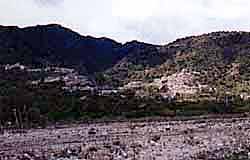
San Nicola - Panorama |
She is supposed to have sais: “hic habitatio mea est, et Ego protecto
popoli hujus civitatis ero” (this is my home and I protect the
people whose citizen I was). The ancient church was submerged
by the river’s flooding and the construction now present was built
at the end of the last century. Even today, every second Sunday
of the month sees the celebrations in honour of Santa Maria di
Crochi. On the Saturday beforehand
all the last tourists and the people of the place enliven the
festivities with goat’s meat and pork sausages.

Gurna Nigra |
These meats are slain
on the spot and accompanied by handmade tumblers of local wine
known as “Cannate”. Today the festivity of Crochi is the solemn
ending of the summer holidays and the fireworks which end the
evening at midnight can be seen as a salutation until the next
summer. Near Crochi are the oligomineral sources of the Carpinuso
waters. From the valley of Crochi, many small roads climb up to
the rural areas of Castania, Obile, Pezzolo and from there to
the heights of the Gremi mountain, 1,241metres high.
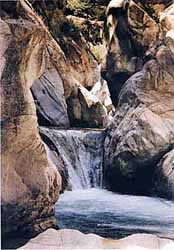
Gurna Nigra
|
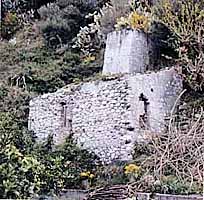
Mill on the Allaro |
|














